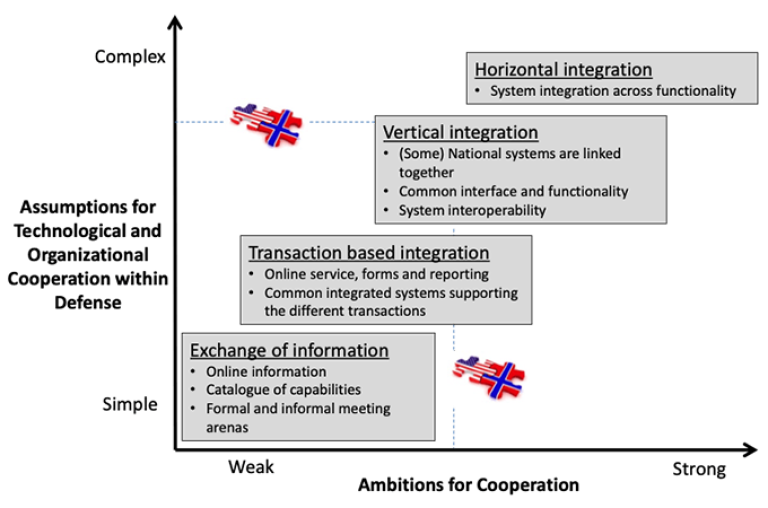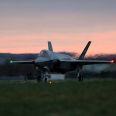"Look to Norway"
Små høyteknologiske nasjoner som Norge kan bidra til at USA og dets allierte beholder sitt teknologiske fortrinn.

— Dette er et lite stykke norgesreklame rettet mot amerikanske beslutningstagere, sier Steder.
Initiativet følger opp konklusjonene i «National Defense Strategy» fra 2018. Der erkjennes det at USA er avhengig av å støtte seg på kompetanse og kapasitet hos allierte og partnere for å nå sine ambisjoner.
— National Review leses i hovedsak av amerikanske beslutningstagere og er regnet som et konservativt nettsted. I disse tider tror jeg det er viktig å nå denne gruppen med et budskap om internasjonalt samarbeid, sier Steder.
Kronikken er et resultat av FFIs samarbeid med Naval Postgraduate School (NPS). Medforfatter Leo Blanken er professor ved NPS og tilknyttet tenketanken The Atlantic Council. Stephen Rodriguez er forsvarspolitisk rådgiver, har grunnlagt One Defence og er «visiting professor» ved Naval Postgraduate School.
Under kan du lese kronikken i sin helhet.
To Shore Up the Defense-Industrial Base, Look to Norway
Mutually beneficial defense partnerships are increasingly important in an era of Russian aggression and rapid technological change.
By Stephen Rodriguez, Frank Brundtland Steder & Leo Blanken
On March 1, 1848, Henry John Temple Palmerston said in the House of Commons: “We have no eternal allies, and we have no perpetual enemies. Our interests are eternal and perpetual.” Over 100 years later, U.S. secretary of state Henry Kissinger famously echoed this realist sentiment. While he was referencing a broader view on American national-security interests, his remarks were intuitive to many abroad. America has long been known for operating independently and at will, primarily because its overwhelming political, economic, and military power has allowed it to do so. But this approach is becoming increasingly untenable — especially when it comes to fielding competitive military technology.
In Executive Order 13806, issued July 2017, President Trump ordered a comprehensive analysis of the assessment and strengthening of the U.S. manufacturing and defense industrial base. The sobering result from the analysis is that the U.S. is struggling: increasingly dependent on foreign suppliers, losing its domestic manufacturing capabilities, and suffering from a decline in science, technology, engineering and mathematics skills among its citizens.
What can be done to remedy this situation? We think, as stated in the National Defense Strategy, that strategic collaboration with a trusted partner nation such as Norway — a country with which the US recently signed a Security of Supply Agreement — can help shore up supply chains and strengthen alliances for both countries.
The American national-security apparatus was codified with the 1947 National Security Act. Following lessons from the Second World War, the resulting architecture served the nation well throughout the Cold War. The industrial base during that period flourished, for a number of reasons. First, the U.S. economy and that of the Soviet Union were almost completely separate. Second, the trajectory of strategic technologies was relatively stable and well-understood. Third, the US Department of Defense was the nation’s and probably the world’s largest source of research and development funding.
But a look at today’s national-security landscape shows that none of these three conditions currently holds. The American economy is intimately entwined with that of China, technology is changing extremely rapidly, and many private firms have R&D budgets larger than that of the Pentagon. The result is that the U.S. government may no longer have the luxury of understanding, let alone unilaterally controlling, the current challenges and future needs of the defense-industrial base. This raises the question: If America cannot control its industrial destiny, who can it rely on?
The answer may lie with our allies.
Why Norway?
America’s allies bring disparate resources to the table for mutual defense. Some have very capable military forces (United Kingdom), geostrategic locations (Djibouti), or shared regional concerns (Canada). We are concerned with partner nations that have the capacity to make significant contributions to the industrial-base issue, due to deeply aligned geopolitical interests, rich human capital, niche high-tech industrial capabilities, and the complementary desire for advanced weapons systems. There are a number of such nations, but here we explore one: Norway. Its internal capacity, relationship with the U.S. defense community, and involvement in previous “big wins” help make the case that many current industrial-base shortfalls could be addressed through the development of coordinated engagement with such partner nations.
There are some major differences between the two countries, not least their size. The U.S. spends about 100 times more than does Norway on defense. The relationship is also marked by complexity, as shown in Figure 1, making it an ideal candidate for defense industrial base integration.

Figure 1 reveals that international cooperation depends on both partner nation ambitions and assumptions. As the boxes illustrate, “cooperation” can range from a simple exchange of information to horizontal integration. The current level of cooperation between the U.S. and Norway is illustrated by the two jigsaw pieces in Figure 1. This indicates that both partner nations would like greater complex technological and organizational cooperation. However, they are currently content to engage each other on a transactional basis. This imbalance between assumptions and ambitions for international cooperation presents an opportunity for both countries’ industrial bases.
Norway holds a highly competitive defense-industry base that delivers niche defense capabilities for an international market. The Norwegian Defence Research Establishment (FFI), where one of us works, is the most important defense-research organization and adviser on defense-related science and technology in Norway. It conducts research on a number of topics, ranging from the assistance of operational units, to the development of defense systems fit for an arctic climate, to the support of national-security policy. Norway’s geopolitical importance, its unique topography, and its cold climate raise the stakes for its military and defense systems — hence the Norwegian Armed Forces’ need for an unrivaled research-and-development program and a high-tech national industrial base.
Since the establishment of FFI in 1946, the institution has, in collaboration with the national-defense industry, contributed to some impressive Norwegian-made military technology. The U.S. recently purchased Naval Strike Missiles (NSM) from Norway, a project whose development dates back to the 1950s, with the development of the anti-submarine weapon, “Terne.” Terne was part of the Norwegian Armed Forces for decades before being sold to the U.S., and contributed to Norwegian company Kongsberg’s ascent as an international high-tech missile developer.
When Kongsberg and American defense conglomerate Raytheon joined forces in 2015 on the NSM project, Raytheon gained access to the European defense market as the Norwegian company gained access to markets outside Europe. The NSM is already in production in Norway, but parts of the missile could eventually be built and assembled in the U.S. for new combat ships. Such an outcome would likely create more jobs in the US and be a win-win situation for the two countries’ defense-industrial bases.
Since the 1950s, Norway has been involved in ammunition development. Following World War II, different threat scenarios created an operational need for a new type of ammunition for the F5 Freedom Fighter. (Norway received the F5 from the USA in 1964.) Since the ammunition that was available at the time had limited effect against light armored vessels, FFI started developing ammunition that could reach the inside of a target. Their eventual solution — ammunition which fragmented inside the target and had a fire-starting effect — was the first version of multi-purpose ammunition, a major international success for Nammo and the Norwegian defense industry.
FFI has also experimented with commercial products for use in a military setting. A small Norwegian company demonstrated to FFI in 2008 its patented solution to stabilize rotor movements on small, “nano” unmanned air vehicles. A few years later, this patented solution resulted in the establishment of Prox Dynamics and the development of a tailored nano-UAV for military purposes. Named Black Hornet, the product designed as a personal surveillance and reconnaissance tool for front-line soldiers. In 2016, Prox Dynamics was acquired by American company FLIR Systems.
A final example of U.S.–Norway cooperation is the “Hacking 4Allies” project, recently launched by FFI in cooperation with several other groups. The basic idea with the project is that Norwegian startups can help improve national security in both the U.S. and Norway.
The need for ambitions in international cooperation
Norway and the U.S. are among the twelve founding countries of NATO. Since the origin of the alliance, much has changed about the security environment. Modern NATO is facing a two-front war—Islamic extremism to the south, Russian adventurism to the east—that demands an increase in bilateral, regional, and transatlantic cooperation.
International cooperation is often used as a foreign-policy tool to improve domestic defense priorities. It adds legitimacy to a program and gives it advocates in the national-government debate. As long as the ambition between two partners for cooperation is strong, and the end goals are the same, they can work well together. And when two countries are cooperating, their combined expertise is broader, more robust.
The benefits of ramped-up cooperation between Norway and the U.S. would abound for both countries. Norway would gain access to a wider variety of high-tech military goods, thanks to reductions in the average cost of production and increases in the volume of goods produced. Norwegian firms could also benefit through the availability of better and sometimes cheaper inputs, becoming more competitive at home and abroad. The defense industry has already experienced the tumult of globalization and defense mergers, complicating things for smaller companies. We believe that Norwegian firms would improve their cost efficiency and culture of entrepreneurship with a greater access to the American defense market, which, in combination with access to American capital goods, would improve their overall quality of production.
Bilateral cooperation would also bring significant benefits for Washington. Countries like Norway offer excellent industrial agility, leveraging their honed manufacturing and technology prowess to bring products to market in a way that larger industrial bases like America’s struggle to do. These smaller economies also naturally encourage openness and innovation for a simple reason: They must trade to survive.
This opens up a valuable opportunity for American acquisition experts to identify critical technologies that the Department of Defense requires, but that are too niche to rely on a single customer. Mature U.S. partners could receive access to new customers, innovative products, and management practices through collaboration with smaller Norwegian companies. Smaller nations, such as Norway, have proven themselves to be very adept at anticipating market trends, capitalizing on new technologies, and using their lean structures to develop high-tech defense systems in a cost-effective way.
The concept of relying on trusted foreign partners to spread the cost of defense goods across a market is crucial as the U.S. considers the limits of its defense budget. In an age where state-of-the-art technology is increasingly found in the commercial marketplace, countries can no longer rely only on the strength of their own industrial base. Entrepreneurs and the defense industry need each other more than ever. Thankfully, their needs and their strengths are often opposite and complementary.
Over the years, the U.S. has been a major security-policy player in Europe. Recent developments in Russia ensure that this will continue. Norway’s geographical situation, the lessons it has learned from its history, and its considerable engagement in security issues has strengthened its position and the role it plays in the transatlantic security-policy area. This relationship is more important than it has been in years — not only thanks to Russia’s resurgence but also thanks to America’s realization that it must have redundancy and be assured of its technology production abilities and supply chain in order to win a major war. The case of Norway shows that such relationships could be individually deepened and generally “scaled up” to answer today’s industrial base challenges.
